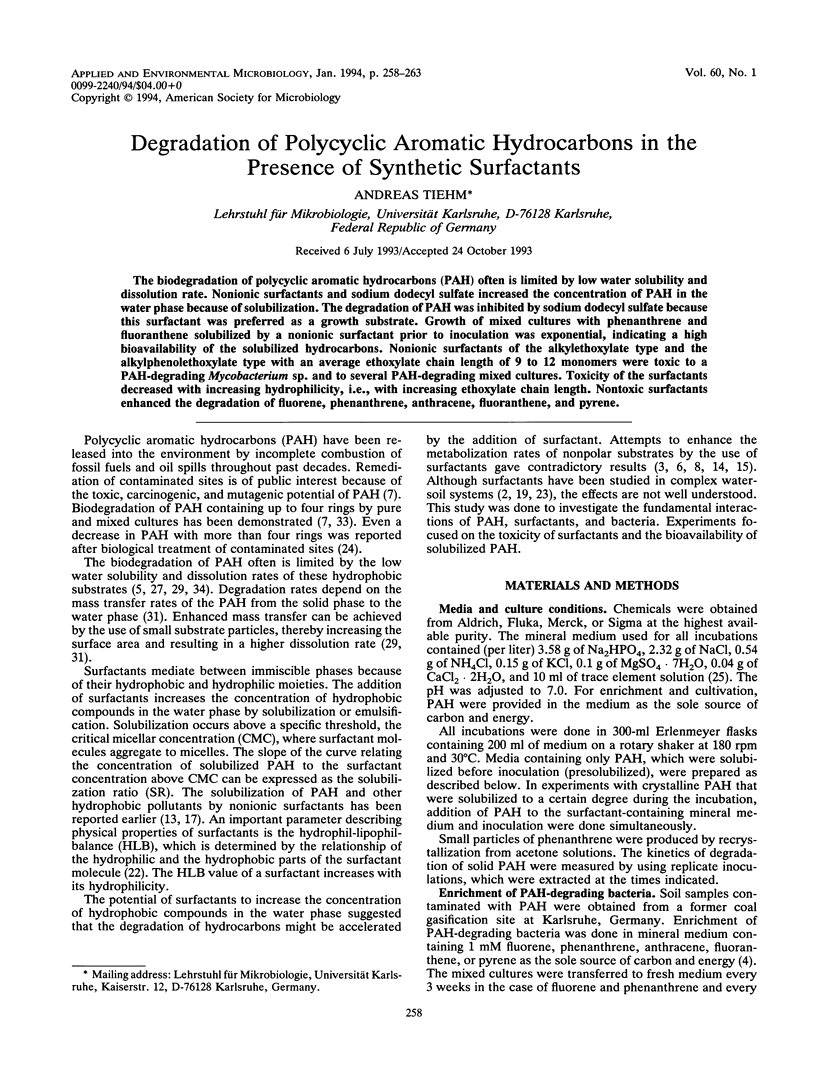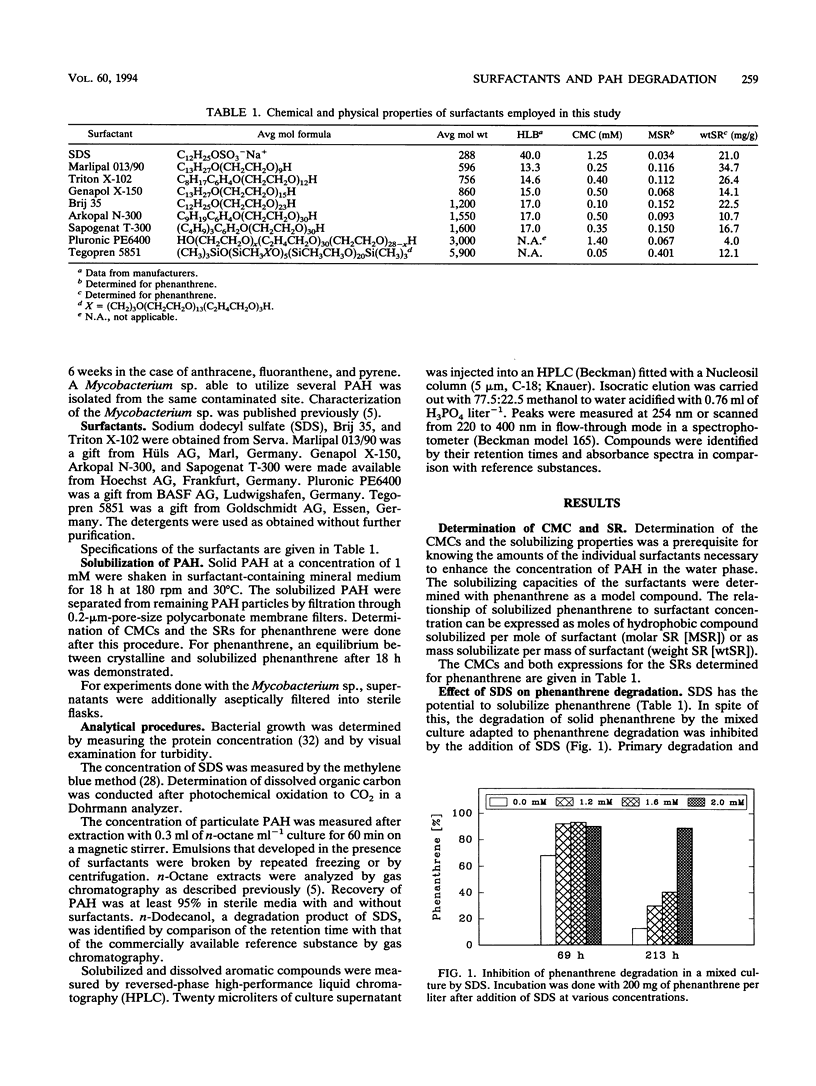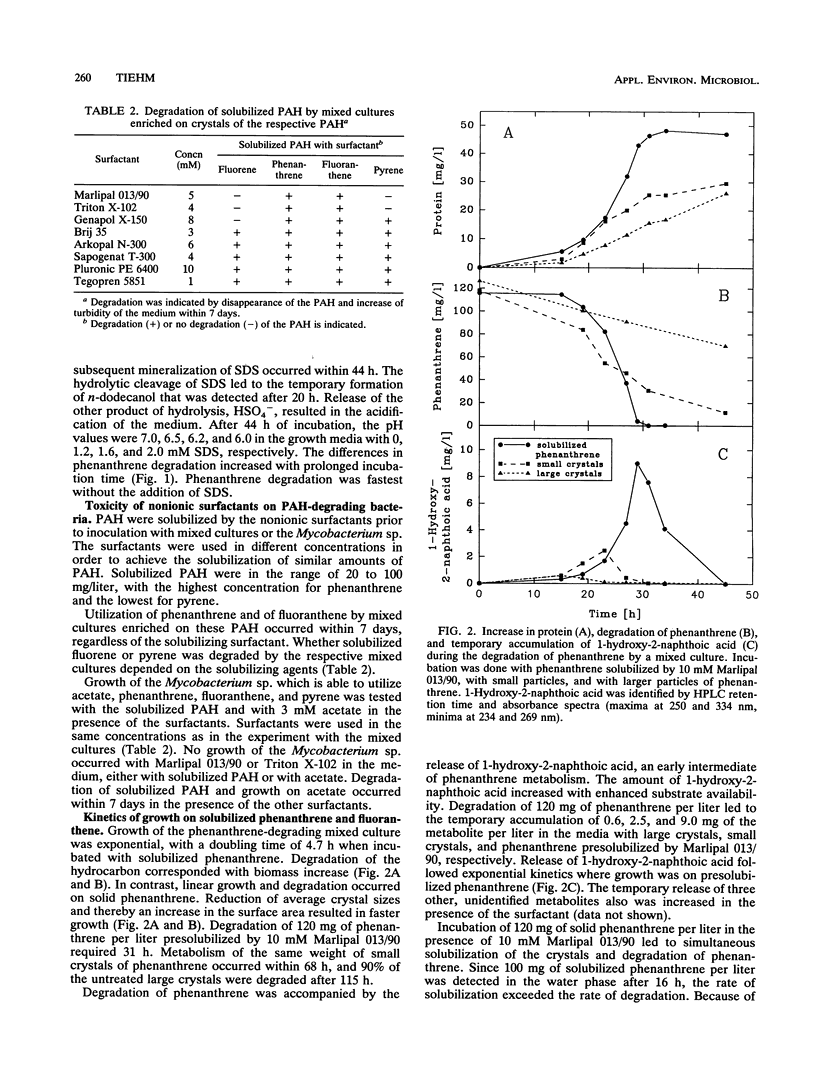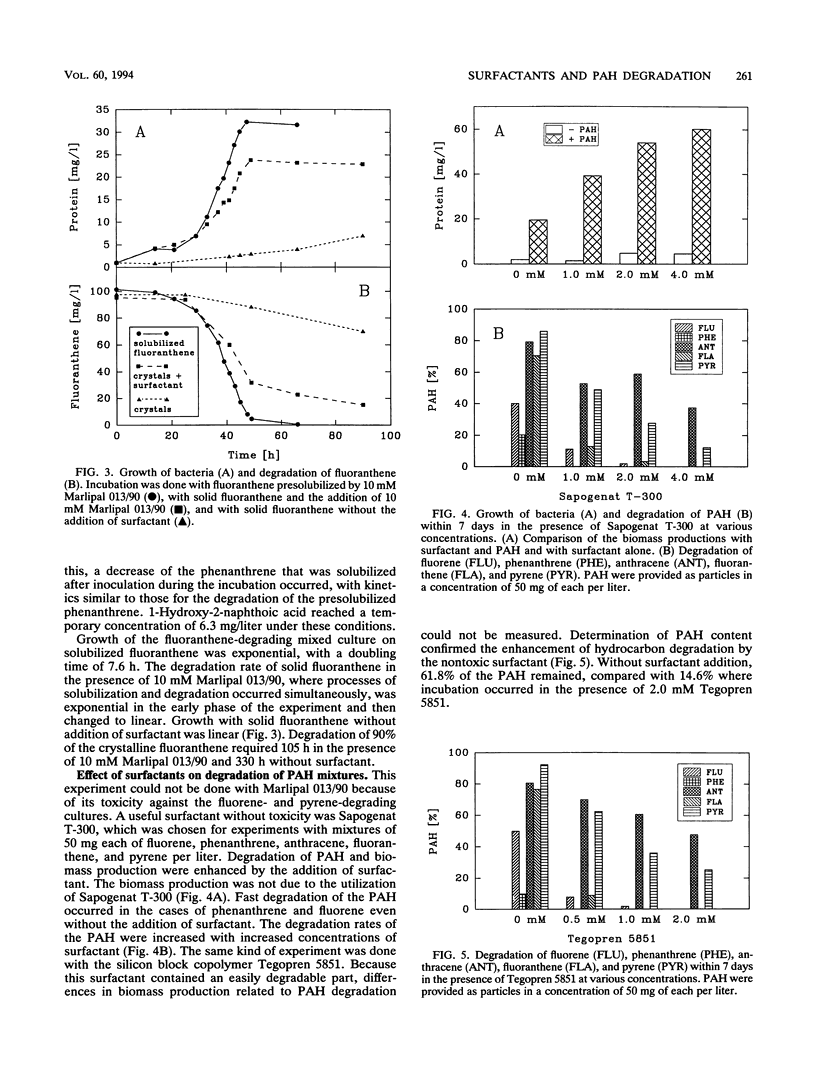Abstract
The biodegradation of polycyclic aromatic hydrocarbons (PAH) often is limited by low water solubility and dissolution rate. Nonionic surfactants and sodium dodecyl sulfate increased the concentration of PAH in the water phase because of solubilization. The degradation of PAH was inhibited by sodium dodecyl sulfate because this surfactant was preferred as a growth substrate. Growth of mixed cultures with phenanthrene and fluoranthene solubilized by a nonionic surfactant prior to inoculation was exponential, indicating a high bioavailability of the solubilized hydrocarbons. Nonionic surfactants of the alkylethoxylate type and the alkylphenolethoxylate type with an average ethoxylate chain length of 9 to 12 monomers were toxic to a PAH-degrading Mycobacterium sp. and to several PAH-degrading mixed cultures. Toxicity of the surfactants decreased with increasing hydrophilicity, i.e., with increasing ethoxylate chain length. Nontoxic surfactants enhanced the degradation of fluorene, phenanthrene, anthracene, fluoranthene, and pyrene.
Full text
PDF





Selected References
These references are in PubMed. This may not be the complete list of references from this article.
- Atrat P. G., Koch B., Szekalla B., Hörhold-Schubert C. Application of newly synthesized detergents in the side chain degradation of plant sterols by Mycobacterium fortuitum. J Basic Microbiol. 1992;32(3):147–157. doi: 10.1002/jobm.3620320302. [DOI] [PubMed] [Google Scholar]
- Boldrin B., Tiehm A., Fritzsche C. Degradation of phenanthrene, fluorene, fluoranthene, and pyrene by a Mycobacterium sp. Appl Environ Microbiol. 1993 Jun;59(6):1927–1930. doi: 10.1128/aem.59.6.1927-1930.1993. [DOI] [PMC free article] [PubMed] [Google Scholar]
- Cox D. P., Williams A. L. Biological Process for Converting Naphthalene to cis-1,2-Dihydroxy-1,2-Dihydronaphthalene. Appl Environ Microbiol. 1980 Feb;39(2):320–326. doi: 10.1128/aem.39.2.320-326.1980. [DOI] [PMC free article] [PubMed] [Google Scholar]
- Dibble J. T., Bartha R. Effect of environmental parameters on the biodegradation of oil sludge. Appl Environ Microbiol. 1979 Apr;37(4):729–739. doi: 10.1128/aem.37.4.729-739.1979. [DOI] [PMC free article] [PubMed] [Google Scholar]
- Foght J. M., Gutnick D. L., Westlake D. W. Effect of emulsan on biodegradation of crude oil by pure and mixed bacterial cultures. Appl Environ Microbiol. 1989 Jan;55(1):36–42. doi: 10.1128/aem.55.1.36-42.1989. [DOI] [PMC free article] [PubMed] [Google Scholar]
- Guerin W. F., Jones G. E. Mineralization of phenanthrene by a Mycobacterium sp. Appl Environ Microbiol. 1988 Apr;54(4):937–944. doi: 10.1128/aem.54.4.937-944.1988. [DOI] [PMC free article] [PubMed] [Google Scholar]
- Miller R. M., Bartha R. Evidence from liposome encapsulation for transport-limited microbial metabolism of solid alkanes. Appl Environ Microbiol. 1989 Feb;55(2):269–274. doi: 10.1128/aem.55.2.269-274.1989. [DOI] [PMC free article] [PubMed] [Google Scholar]
- Oberbremer A., Müller-Hurtig R., Wagner F. Effect of the addition of microbial surfactants on hydrocarbon degradation in a soil population in a stirred reactor. Appl Microbiol Biotechnol. 1990 Jan;32(4):485–489. doi: 10.1007/BF00903788. [DOI] [PubMed] [Google Scholar]
- Stucki G., Alexander M. Role of dissolution rate and solubility in biodegradation of aromatic compounds. Appl Environ Microbiol. 1987 Feb;53(2):292–297. doi: 10.1128/aem.53.2.292-297.1987. [DOI] [PMC free article] [PubMed] [Google Scholar]
- Thomas J. M., Yordy J. R., Amador J. A., Alexander M. Rates of dissolution and biodegradation of water-insoluble organic compounds. Appl Environ Microbiol. 1986 Aug;52(2):290–296. doi: 10.1128/aem.52.2.290-296.1986. [DOI] [PMC free article] [PubMed] [Google Scholar]
- Wang C., Smith R. L. Lowry determination of protein in the presence of Triton X-100. Anal Biochem. 1975 Feb;63(2):414–417. doi: 10.1016/0003-2697(75)90363-2. [DOI] [PubMed] [Google Scholar]
- Weissenfels W. D., Beyer M., Klein J. Degradation of phenanthrene, fluorene and fluoranthene by pure bacterial cultures. Appl Microbiol Biotechnol. 1990 Jan;32(4):479–484. doi: 10.1007/BF00903787. [DOI] [PubMed] [Google Scholar]
- Wodzinski R. S., Coyle J. E. Physical state of phenanthrene for utilization by bacteria. Appl Microbiol. 1974 Jun;27(6):1081–1084. doi: 10.1128/am.27.6.1081-1084.1974. [DOI] [PMC free article] [PubMed] [Google Scholar]


